airbag off SUZUKI JIMNY 2019 Owners Manual
[x] Cancel search | Manufacturer: SUZUKI, Model Year: 2019, Model line: JIMNY, Model: SUZUKI JIMNY 2019Pages: 421, PDF Size: 6.35 MB
Page 16 of 421
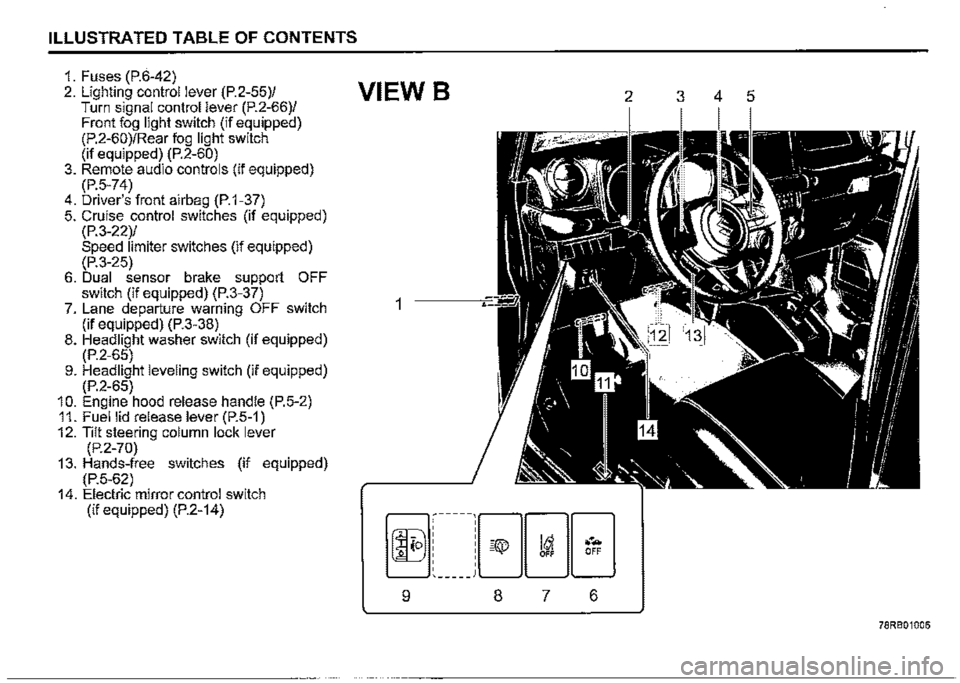
ILLUSTRATED TABLE OF CONTENTS
1. Fuses (P.6-42) 2. Lighting control lever (P.2-55)/ Turn signal control lever (P.2-66)/ Front fog light switch (if equipped) (P.2-60)/Rear fog light switch (if equipped) (P.2-60) 3. Remote audio controls (if equipped) (P.5-74) 4. Driver's front airbag (P.1-37) 5. Cruise control switches (if equipped) (P.3-22)/ Speed limiter switches (if equipped) (P.3-25) 6. Dual sensor brake support OFF switch (if equipped) (P.3-37) 7. Lane departure warning OFF switch (if equipped) (P.3-38) 8. Headlight washer switch (if equipped) (P.2-65) 9. Headlight leveling switch (if equipped) (P.2-65) 10. Engine hood release handle (P.5-2) 11. Fuel lid release lever (P.5-1) 12. Tilt steering column lock lever (P.2-70) 13. Hands-free switches (if equipped) (P.5-62) 14. Electric mirror control switch (if equipped) (P.2-14)
VIEW B 2 3 4 5
1
-----18·'"' 0til G ... : -\¥-' OFF OFF
' _____ )
9 8 7 6
78RB01006
Page 28 of 421
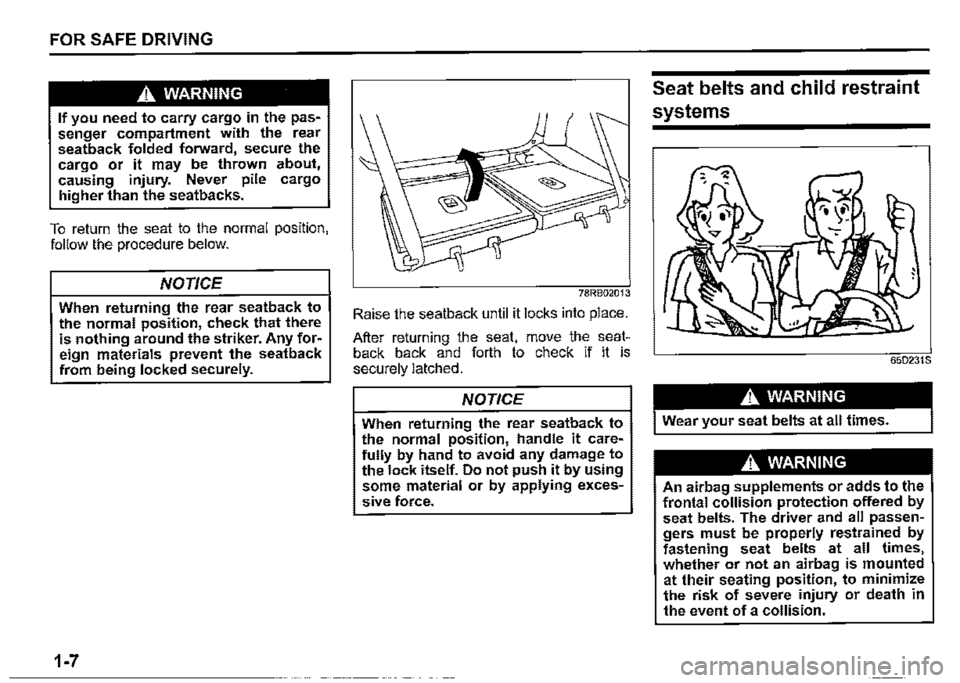
FOR SAFE DRIVING
A. WARNING
If you need to carry cargo in the passenger compartment with the rear seatback folded forward, secure the cargo or it may be thrown about, causing injury. Never pile cargo higher than the seatbacks.
To return the seat to the normal position,
follow the procedure below.
NOTICE
When returning the rear seatback to the normal position, check that there is nothing around the striker. Any foreign materials prevent the seatback from being locked securely.
1-7
78RB02013
Raise the seatback until it locks into place.
After returning the seat, move the seatback back and forth to check if it is securely latched.
NOTICE
When returning the rear seatback to the normal position, handle it carefully by hand to avoid any damage to the lock itself. Do not push it by using some material or by applying exces
sive force.
Seat belts and child restraint
systems
650231S
A. WARNING
An airbag supplements or adds to the frontal collision protection offered by seat belts. The driver and all passengers must be properly restrained by fastening seat belts at all times, whether or not an airbag is mounted at their seating position, to minimize the risk of severe injury or death in the event of a collision.
Page 57 of 421
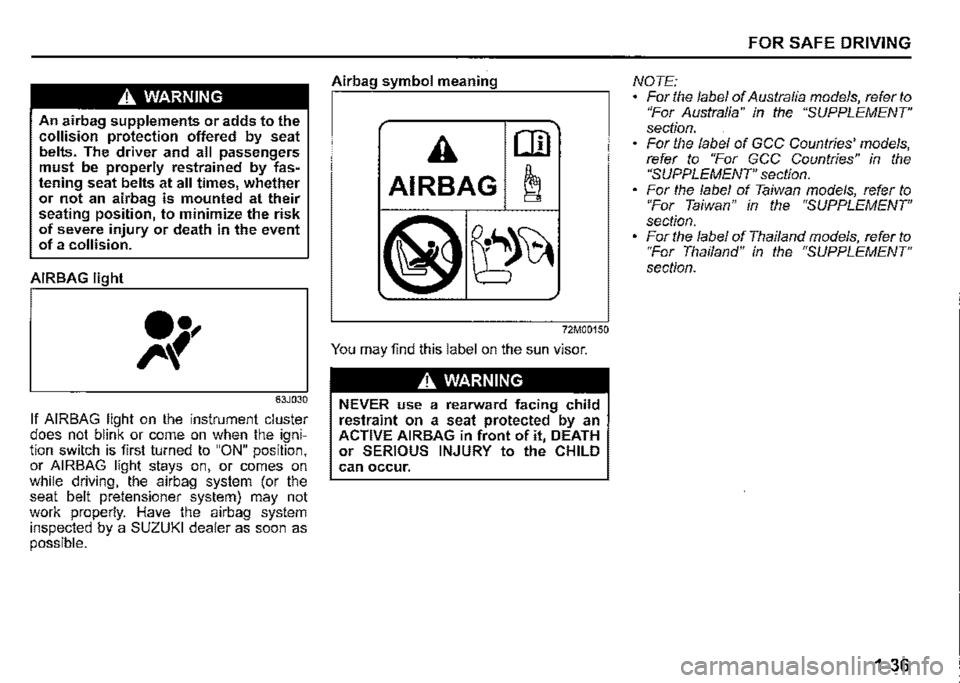
A. WARNING
An airbag supplements or adds to the collision protection offered by seat belts. The driver and all passengers must be properly restrained by fastening seat belts at all times, whether or not an airbag is mounted at their seating position, to minimize the risk of severe injury or death in the event of a collision.
AIRBAG light
63J030
If AIRBAG light on the instrument cluster does not blink or come on when the ignition switch is first turned to "ON" position. or AIRBAG light stays on, or comes on while driving, the airbag system (or the seat belt pretensioner system) may not work properly. Have the airbag system inspected by a SUZUKI dealer as soon as possible.
Airbag symbol meaning
A Dll
AIRBAG ~
®
@t
72M00150
You may find this label on the sun visor.
A. WARNING
NEVER use a rearward facing child restraint on a seat protected by an ACTIVE AIRBAG in front of it, DEATH or SERIOUS INJURY to the CHILD can occur.
FOR SAFE DRIVING
NOTE: For the label of Australia models, refer to "For Australia" in the "SUPPLEMENT" section. For the label of GCC Countries' models, refer to "For GCC Countries" in the "SUPPLEMENT" section. For the label of Taiwan models, refer to "For Taiwan" in the "SUPPLEMENT" section. For the label of Thailand models, refer to "For Thailand" in the "SUPPLEMENT" section.
1-36
Page 58 of 421
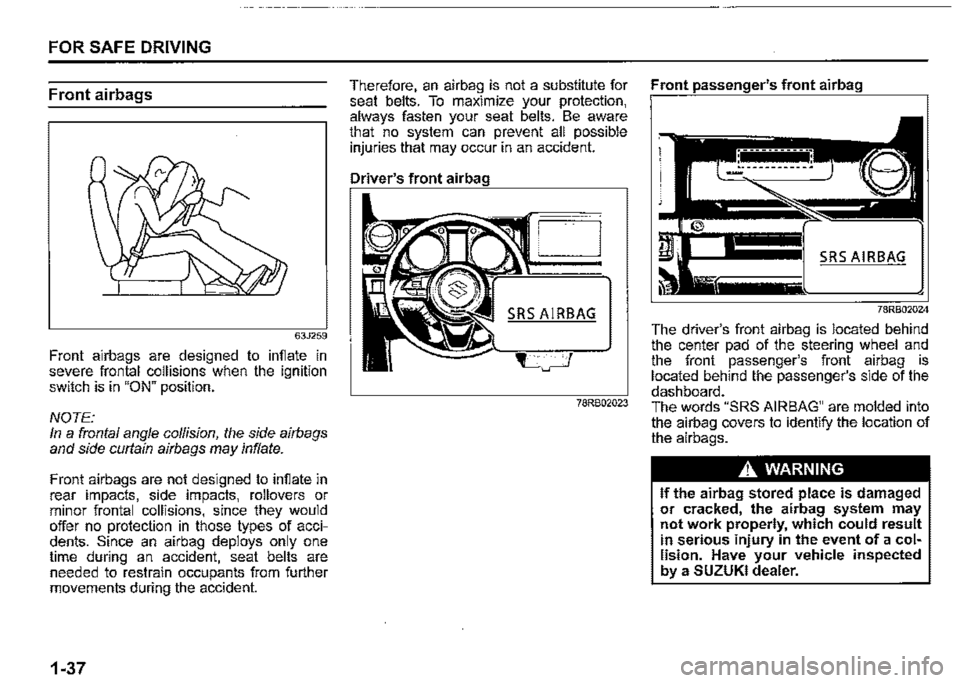
FOR SAFE DRIVING
Front airbags
63J259
Front airbags are designed to infiate in severe frontal collisions when the ignition switch is in "ON" position.
NOTE: In a frontal angle collision, the side airbags and side cwtain airbags may inflate.
Front airbags are not designed to infiate in rear impacts, side impacts, rollovers or minor frontal collisions, since they would offer no protection in those types of accidents. Since an airbag deploys only one time during an accident, seat belts are needed to restrain occupants from further movements during the accident.
1-37
Therefore, an airbag is not a substitute for Front passenger's front airbag seat belts. To maximize your protection, always fasten your seat belts. Be aware that no system can prevent all possible injuries that may occur in an accident.
Driver's front airbag
D
SRS AIRBAG
78RB02023
SRS AIRBAG
78RB02024
The driver's front airbag is located behind the canter pad of the steering wheel and the front passenger's front airbag is located behind the passenger's side of the dashboard. The words "SRS AIRBAG" are melded into the airbag covers to identify the location of the airbags.
A WARNING
If the airbag stored place is damaged or cracked, the airbag system may not work properly, which could result in serious injury in the event of a collision. Have your vehicle inspected by a SUZUKI dealer.
Page 62 of 421

FOR SAFE DRIVING
80J110
• Vehicle rollover
NOTE: For vehicle equipped with the "Emergency
road assistance -global navigation satellite system (ERA-GLONASS)", refer to "Emergency Road Assistance -Global Navigation Satellite System (ERA-GLONASS)" in "For Russia and other countries adopting ERA-GLONASS" in the "SUPPLEMENT" section for further information.
1-41
Side airbags and side curtain air
bags
68KM090
Side airbags and side curtain airbags are designed to inflate in severe side impact collisions when the ignition switch is in "ON" position.
Side airbags and side curtain airbags are not designed to inflate in frontal or rear collisions, rollovers or minor side collisions, since they would offer no protection in those types of accidents. Only the side airbag and side curtain airbag on the side of the vehicle that is struck will inflate. However, in a frontal angle collision, the side airbags and side curtain airbags may inflate. Since an airbag deploys only one time during an accident, seat belts are needed to restrain occupants from further movements during the accident.
Therefore, an airbag is not a substitute for seat belts. To maximize your protection, always fasten your seat belts. Be aware that no system can prevent all possible injuries that may occur in an accident.
Side airbags
78RB02025
Side airbags are located in the part of the front seatbacks closest to the doors. The "SRS AIRBAG" labels are attached to the seatbacks to identify the location of the side airbags.
Page 65 of 421

80J125
Impact from the side by a motorcycle or
bicycle
80J126
Collision with a utility pole or stumpage
FOR SAFE DRIVING
Side airbags and side curtain airbags do not inflate How the system works
80J120
• Impact from the rear
80J110
• Vehicle rollover
In a frontal collision, the crash sensors will detect rapid deceleration, and if the controller judges that the deceleration represents a severe frontal collision, the controller will trigger the infiators. If your vehicle is equipped with side airbags and side curtain airbags, crash sensors will detect a side collision, and if the controller judges that the side collision is severe enough, it will trigger the side airbag and side curtain airbag infiators. The infiators inflate the appropriate airbags with nitrogen or argon gas. The infiated airbags provide a cushion for your head (front airbags and side curtain airbags only) and upper body. The airbag inflates and defiates so quickly that you may not even realize that it has activated. The airbag will neither hinder your view nor make it harder to exit the vehicle.
Airbags must infiate quickly and forcefully in order to reduce the chance of serious or fatal injuries. However, an unavoidable consequence of the quick infiation is that the airbag may irritate bare skin, such as the facial area against a front airbag. Wash off any residue as soon as possible to prevent skin irritation. Also, upon inflation, a loud noise will occur and some powder and smoke will be released. These conditions are not harmful and do not indicate a fire in the vehicle. Be aware, however, that some airbag components may be hot for a while after infiation.
1-44
Page 68 of 421

FOR SAFE DRIVING
Front passenger airbag deactiva
tion system (if equipped)
(2)
78RB02027
The front passenger's front airbag system must be deactivated if a child restraint system is to be installed on the front passenger's seat. When the ignition switch is turned to "ON" position, "PASSENGER AIRBAG ON" indicator (1) or "PASSENGER AIRBAG OFF" indicator (2) shows whether the front passenger's airbag system is activated or deactivated.
1-47
When the front passenger's airbag system is activated, both "PASSENGER AIRBAG ON" indicator (1) and "PASSENGER AIRBAG OFF" indicator (2) come on for a few seconds and then go out. After that, only "PASSENGER AIRBAG ON" indicator (1) comes on for about 1 minute and then goes out.
When the front passenger's airbag system is deactivated, both "PASSENGER AIRBAG ON" indicator (1) and "PASSENGER AIRBAG OFF" indicator (2) come on for a few seconds and then go out. After that, only "PASSENGER AIRBAG OFF" indicator (2) comes on.
When you activate or deactivate the front passenger's airbag system, check which indicator is on before starting the engine.
Side airbags, side curtain airbags and seat belt pretensioners are not connected to the airbag deactivation system. Even if the front passenger's airbag system is deactivated, side airbags, side curtain airbags and seat belt pretensioners are still activated.
58MS030
.A WARNING
When using child restraint system on the front passenger's seat, the front passenger's airbag system must be deactivated; otherwise deployment of the front passenger's airbag could result in the death or serious injury of the child.
.A WARNING
Check that the front passenger's airbag system is activated and "PASSENGER AIRBAG ON" indicator (1) is on whenever there is no child restraint installed on the front passenger's seat.
Page 69 of 421
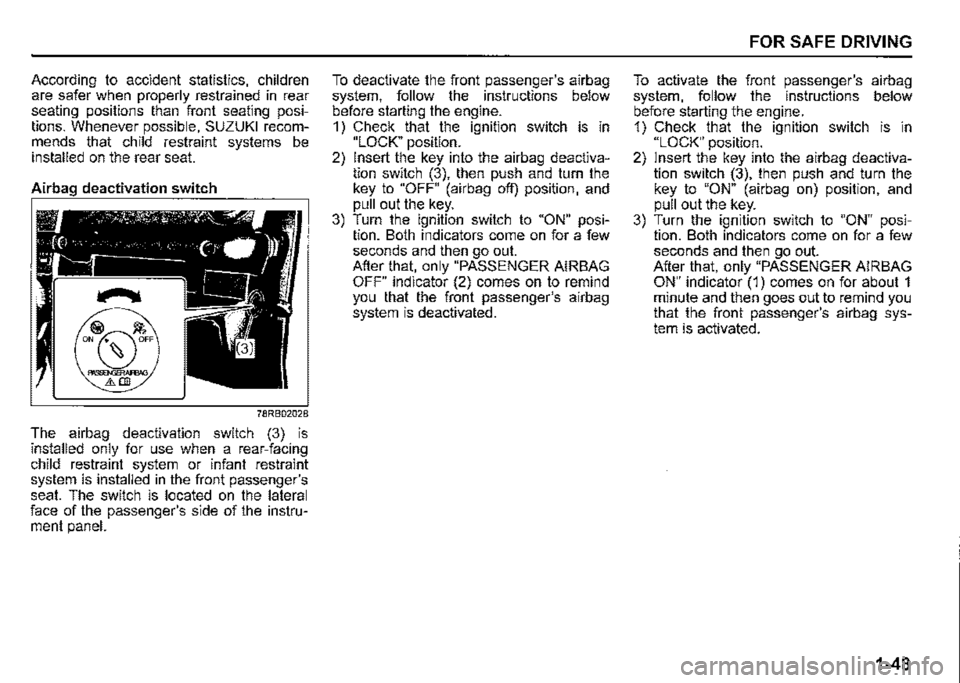
According to accident statistics, children are safer when properly restrained in rear seating positions than front seating positions. Whenever possible, SUZUKI recommends that child restraint systems be installed on the rear seat.
Airbag deactivation switch
78RB02028
The airbag deactivation switch (3) is installed only for use when a rear-facing child restraint system or infant restraint system is installed in the front passenger's seat. The switch is located on the lateral face of the passenger's side of the instrument panel.
To deactivate the front passenger's airbag system, follow the instructions below before starting the engine. 1) Check that the ignition switch is in "LOCK" position. 2) Insert the key into the airbag deactivation switch (3), then push and turn the key to "OFF" (airbag off) position, and pull out the key. 3) Turn the ignition switch to "ON" position. Both indicators come on for a few seconds and then go out. After that, only "PASSENGER AIRBAG OFF" indicator (2) comes on to remind you that the front passenger's airbag system is deactivated.
FOR SAFE DRIVING
To activate the front passenger's airbag system, follow the instructions below before starting the engine. 1) Check that the ignition switch is in "LOCK" position. 2) Insert the key into the airbag deactivation switch (3), then push and turn the key to "ON" (airbag on) position, and pull out the key. 3) Turn the ignition switch to "ON" position. Both indicators come on for a few seconds and then go out. After that, only "PASSENGER AIRBAG ON" indicator (1) comes on for about 1 minute and then goes out to remind you that the front passenger's airbag system is activated.
1-48
Page 224 of 421
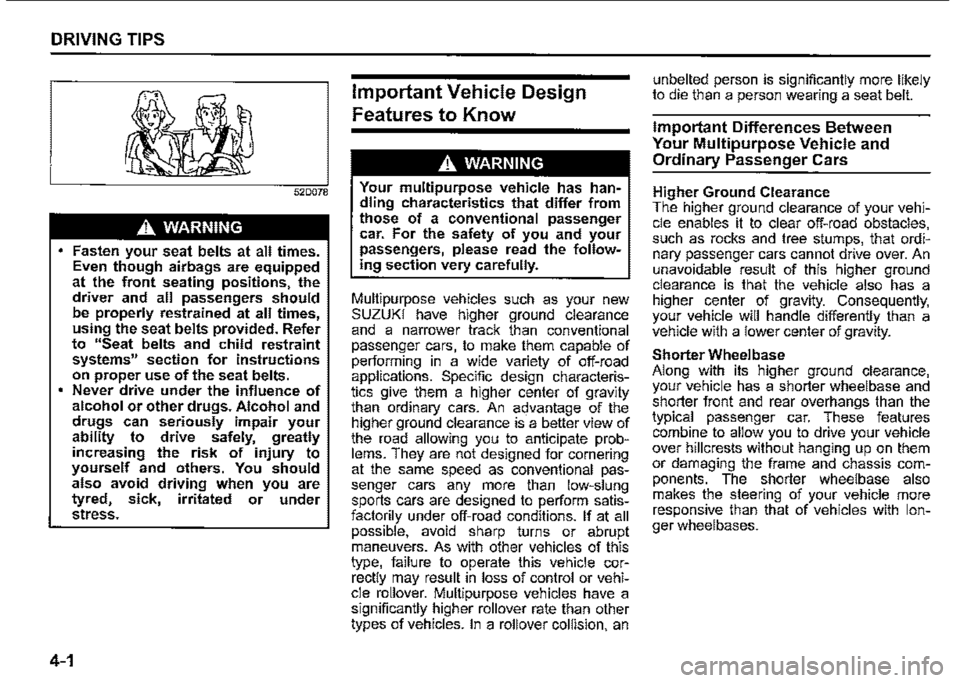
DRIVING TIPS
52D078
A WARNING
Fasten your seat belts at all times. Even though airbags are equipped at the front seating positions, the driver and all passengers should be properly restrained at all times, using the seat belts provided. Refer to "Seat belts and child restraint systems" section for instructions on proper use of the seat belts. Never drive under the influence of alcohol or other drugs. Alcohol and drugs can seriously impair your ability to drive safely, greatly increasing the risk of injury to yourself and others. You should also avoid driving when you are tyred, sick, irritated or under stress.
4-1
Important Vehicle Design
Features to Know
A WARNING
Your multipurpose vehicle has handling characteristics that differ from those of a conventional passenger car. For the safety of you and your passengers, please read the following section very carefully.
Multipurpose vehicles such as your new SUZUKI have higher ground clearance and a narrower track than conventional passenger cars, to make them capable of performing in a wide variety of off-road applications. Specific design characteristics give them a higher center of gravity than ordinary cars. An advantage of the higher ground clearance is a better view of the road allowing you to anticipate problems. They are not designed for cornering at the same speed as conventional passenger cars any more than low-slung sports cars are designed to perform satisfactorily under off-road conditions. If at all possible, avoid sharp turns or abrupt maneuvers. As with other vehicles of this type, failure to operate this vehicle correctly may result in loss of control or vehicle rollover. Multipurpose vehicles have a significantly higher rollover rate than other types of vehicles. In a rollover collision, an
unbelted person is significantly more likely to die than a person wearing a seat belt.
Important Differences Between
Your Multipurpose Vehicle and
Ordinary Passenger Cars
Higher Ground Clearance The higher ground clearance of your vehicle enables it to clear off-road obstacles, such as rocks and tree stumps, that ordinary passenger cars cannot drive over. An unavoidable result of this higher ground clearance is that the vehicle also has a higher center of gravity. Consequently, your vehicle will handle differently than a vehicle with a lower center of gravity.
Shorter Wheelbase Along with its higher ground clearance, your vehicle has a shorter wheelbase and shorter front and rear overhangs than the typical passenger car. These features combine to allow you to drive your vehicle over hillcrests without hanging up on them or damaging the frame and chassis components. The shorter wheelbase also makes the steering of your vehicle more responsive than that of vehicles with longer wheelbases.
Page 412 of 421
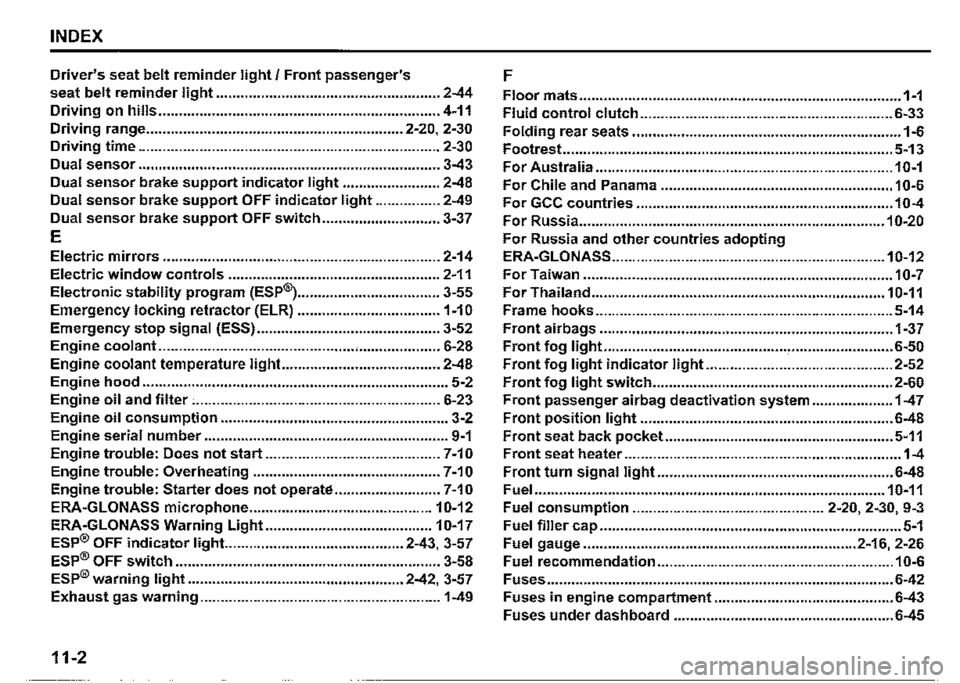
INDEX
Driver's seat belt reminder light/ Front passenger's F seat belt reminder light ....................................................... 2-44 Floor mats ............................................................................... 1-1 Driving on hills ..................................................................... 4-11 Fluid control clutch .............................................................. 6-33 Driving range ............................................................... 2-20, 2-30 Folding rear seats .................................................................. 1-6 Driving time .......................................................................... 2-30 Footrest ................................................................................. 5-13 Dual sensor .......................................................................... 3-43 For Australia ......................................................................... 10-1 Dual sensor brake support indicator light ........................ 2-48 For Chile and Panama ......................................................... 10-6 Dual sensor brake support OFF indicator light ................ 2-49 For GCC countries ............................................................... 10-4 Dual sensor brake support OFF switch ............................. 3-37 For Russia ........................................................................... 10-20
E For Russia and other countries adopting
Electric mirrors .................................................................... 2-14 ERA-GLONASS ................................................................... 10-12
Electric window controls .................................................... 2-11 For Taiwan ............................................................................ 10-7
Electronic stability program (ESP®) ................................... 3-55 For Thailand ........................................................................ 10-11
Emergency locking retractor (ELR) ..................................• 1-1 O Frame hooks ......................................................................... 5-14
Emergency stop signal (ESS) ............................................. 3-52 Front airbags ........................................................................ 1-37
Engine coolant ..................................................................... 6-28 Front fog light ............................................. , ......................... 6-50
Engine coolant temperature light ....................................... 2-48 Front fog light indicator light .............................................. 2-52
Engine hood ........................................................................... 5-2 Front fog light switch ........................................................... 2-60
Engine oil and filter , ............................................................ 6-23 Front passenger airbag deactivation system .................... 1-47
Engine oil consumption ........................................................ 3-2 Front position light .............................................................. 6-48
Engine serial number ............................................................ 9-1 Front seat back pocket ........................................................ 5-11
Engine trouble: Does not start ........................................... 7-10 Front seat heater .................................................................... 1-4
Engine trouble: Overheating .............................................. 7-1 O Front turn signal light .......................................................... 6-48
Engine trouble: Starter does not operate .......................... 7-10 Fuel ...................................................................................... 10-11
ERA-GLONASS microphone ............................................. 10-12 Fuel consumption ............................................... 2-20, 2-30, 9-3
ERA-GLONASS Warning Light ......................................... 10-17
ESP® OFF indicator light. ........................................... 2-43, 3-57
ESP® OFF switch ................................................................. 3-58
Fuel filler cap .......................................................................... 5-1
Fuel gauge ................................................................... 2-16, 2-26
Fuel recommendation .......................................................... 10-6
ESP® warning light ..................................................... 2-42, 3-57 Fuses ..................................................................................... 6-42
Exhaust gas warning ........................................................... 1-49 Fuses in engine compartment ............................................ 6-43
Fuses under dashboard ...................................................... 6-45
11-2